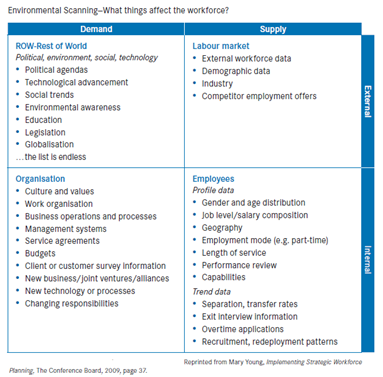ATD Blog
It Takes a People Ecosystem to Future-Skill Your Workforce
Fri Oct 16 2015

Creating sustainable talent pools is critical for bridging talent shortage gaps and increasing productivity in the long run. Future-Skilling Your Workforce, new research published by The Conference Board, examines emerging workplace trends that are reshaping corporate talent and learning strategies. Drawing on experiences and case studies from top human capital practitioners and senior executives from _Booz Allen Hamilton, Disney, Edwards Lifesciences, FedEx Ground, Fidelity Investments, IBM, Kaiser Permanente, Prudential Annuities, and Selective Insurance Company of Americ_a, the report provides new insights, best practices, and tools to help companies engaged in building their talent and organizational capabilities for today and into the future.
The Evolving World of Business
As clichéd as it may sound, the world is indeed changing rapidly. The myriad technological innovations and the rapidly expanding catalogue of the next-big-thing/app (wearables, smart cars, 3-D printing, and so forth) have accelerated the pace of this change. There is an app for almost everything these days. These, combined with larger macroeconomic, environmental, and demographic shifts are influencing not only how we live but also how we conduct our businesses.
To thrive in this evolving business environment, our research found that organizations are looking for employees with “enterprise-wide and collaborative skills with keen understanding of business, abilities to make meaning of chaos, agility to adapt to changing situations, and self-directedness to map their own learning and growth.” In other words, they would need to be:
Curious, passion-driven, lifelong learners:
Sense-makers:
Enterprise workers:
Resilient, adaptive problem-solvers: <decision making
Positive growth mindset:
Multi-skilled:
Increasing organizational ability to find and develop these skills is crucial for sustaining business performance. Another research study by The Conference Board_,_ Prioritizing Productivity to Drive Growth, Competitiveness, and Profitability, shows that having the right talent directly impacts productivity and profitability, and positions organizations to compete in the global economy. Impacts to top and bottom line growth make this more a business conversation and less an HR/talent issue, with CEOs and CHROs/CTOs/CLOs equally concerned about finding, developing, and retaining their top talent.
Maximizing Agility with the People Ecosystem
The People Ecosystem is a necessary prelude to future-skilling your workforce. When it comes to their workforces, many organizations are still operating with a twentieth-century mindset in a twenty-first-century world. According to the report, “HR and talent professionals need to break down silos and look at their efforts holistically—with functions like recruitment, compensation, and training becoming integrated talent processes aligned to a clear business strategy. Similarly, employees can no longer be seen as isolated points on a hierarchical org chart, but rather nodes in a web of networks sprawled across the organization, and beyond. Companies that fail to adapt will find themselves increasingly unable to compete.”
Like its name suggests, this ecosystem concept is envisioned as a living, interconnected structure that anticipates disruptive changes and responds with maximum agility and resilience. In a corporate setting this would call for the urgent breakdown of siloed processes and structures and alignment of all elements of the talent strategy to the enterprise-wide goals. Only a highly distributed, interconnected, and self-adaptive approach—an ecosystem approach—can help organizations thrive in a rapidly changing business environment and, in turn, ensure sustainable talent pools for the short and long terms.
The people ecosystem focuses on three essential components, providing tools and guides within each to help practitioners tie their talent strategies to business goals. The three components are:
Strategic Talent Planning. In a world that faces major talent shortages unlike any in living memory, it is fitting that the people ecosystem adopts a metaphor from nature. We explain in Future-Skilling Your Workforce that, “From Baby Boomer retirement and falling fertility rates to unprepared graduates and the rise of robots in the workplace, today’s HR and learning strategists must balance a dense ecology of long-term demographic forces and socio-cultural pressure points alongside all the traditional internal and marketplace factors. No single executive or department can master these currents on their own.”
The first step toward addressing persisting talent shortages is designing strategic talent plans. The development of these plans follows a problem-identification approach so that instead of filling positions as quickly as possible, each opening presents an opportunity to assess and align talent to the business goals:
internal and external business environment and context are assessed using tools like the environmental scanning tool (see Figure 1)
key business and talent issues are identified and prioritized,
in-depth root cause analysis of issues are done
talent plans are developed and implemented
·outcomes and processes are measured and evaluated.
Figure 1: Environmental Scanning Tool

Results-Focused Execution. No matter how rigorous the five stages of strategic talent planning, they remain void without a robust execution plan. The goal of the execution process is to not only mobilize the talent required to meet the business goals but also to engage the employees and strengthen the sense of joint partnership and commitment between the employees and the organization.
Strategies to attract and acquire critical talent include:
using predictive analytics and assessment tools
recruitment process outsourcing
elevating candidate experiences; investing in school and college graduates as early as grade school-levels, especially in the case of STEM fields
looking at strategies beyond the traditional buy-build-borrow-redeploy approach. For example, in Saudi Arabia, GE changed their business strategy to match the talent supply by joining with Saudi Aramco and Tata Consultancy Services to open the country’s first all-female business-process services and training center to lend support to their businesses. Nearly 1000 women were recruited and trained to support GE businesses alone. (Learn more about this in Buy, Build, Borrow, or None of the Above? New Options for Closing Global Talent Gaps.)
Strategies to connect and develop top talent include:
stages of enculturation
career development related to upward and lateral movements, like in a career-lattice
innovative learning to close skill gaps and foster continuous learning environments
succession planning and leadership development
curation to preserve and manage employee life experiences
ongoing, in-the-moment rewards systems.
Strategic Talent Development and Learning. Learning in the 21st century is global, social, democratized, and on-demand. In an era where untold lifetimes of knowledge are just a click away, traditional classroom formats will no longer work. Learning moments have to be created and captured within work settings for learning to have impact on the individual’s performance. Worldwide, corporate learning is a $130 billion per year business but continued investments in it is heavily dependent on the continued returns on investments.
Designing future-focused programs will require emphasis on two areas (both have been discussed at length in the report with concrete examples, strategies, case studies, and assessment guides):
Repositioning talent and learning functions to align with business strategies—This is an integrated and holistic system promotes greater mobility, collaboration, and agility.
Driving strategic learning by focusing on the “learner experience”—What is the role of the learner? What types of learners are there? Is the learning design to help employees succeed at business, in the workplace, or toward their preferred careers? And, which delivery methods can deliver the best learner experience?
Implications for CHRO, CTO, and CLO
It is clear that all HR and learning-related policies, roles and functions need a refresh in the twenty-first century workplace. To keep up with the rapidly changing pace of business, HR and talent leaders would need:
A new mindset: When Netflix reinvented its HR some years ago, it showed direct increase in their growth. HR was required to think like business people and innovators first, and as HR people next. (Read the full story in the Harvard Business Review article, “How Netflix Reinvented HR.”)
A new vision: HR and talent policies need to be viewed through future-focused lenses to be successful and effective rather than a short term vision that changes quarter-to-quarter.
A new strategy: While technology and globalization have made it possible for organizations to operate without borders, HR and talent functions continue to remain trapped in siloes where they pursue individual goals. Forward-thinking leaders are looking beyond siloed and hierarchical work structures toward an integrated and holistic people ecosystem.
A new tool: Predictive and prescriptive analytics takes the guess-work out of business and talent decisions. HR and talent leaders can leverage this tool to develop targeted strategies that don’t operate in vacuum, but has the ability to make significant impact on business results.
